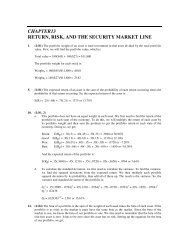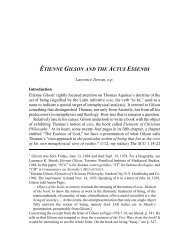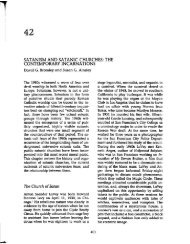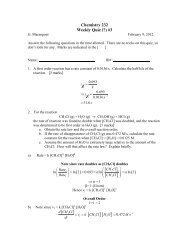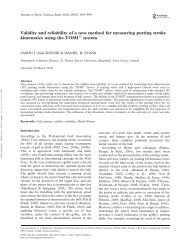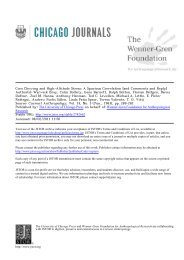Health and the Social Construction of Masculinity in Men's Health ...
Health and the Social Construction of Masculinity in Men's Health ...
Health and the Social Construction of Masculinity in Men's Health ...
You also want an ePaper? Increase the reach of your titles
YUMPU automatically turns print PDFs into web optimized ePapers that Google loves.
10.1177/1097184X03257441 ARTICLE<br />
MEN AND MASCULINITIES / July 2004<br />
Stibbe / MASCULINITY IN MEN’S HEALTH MAGAZINE<br />
<strong>Health</strong> <strong>and</strong> <strong>the</strong> <strong>Social</strong> <strong>Construction</strong> <strong>of</strong><br />
<strong>Mascul<strong>in</strong>ity</strong> <strong>in</strong> Men’s <strong>Health</strong> Magaz<strong>in</strong>e<br />
ARRAN STIBBE<br />
Chikushi Jogakuen University<br />
Although health has not traditionally been a male concern, <strong>the</strong> past few years have seen<br />
<strong>the</strong> gradual development <strong>of</strong> a shared concept <strong>of</strong> men’s health with<strong>in</strong> <strong>the</strong> public doma<strong>in</strong>.<br />
Among <strong>the</strong> lead<strong>in</strong>g participants <strong>in</strong> <strong>the</strong> construction <strong>of</strong> this concept is Men’s <strong>Health</strong> magaz<strong>in</strong>e.<br />
In this article, six issues <strong>of</strong> Men’s <strong>Health</strong> (June-December 2000) are critically analyzed<br />
to reveal <strong>the</strong> ideological assumptions on which <strong>the</strong> discourse <strong>of</strong> <strong>the</strong> magaz<strong>in</strong>e is<br />
based. Evidence is presented that suggests that Men’s <strong>Health</strong> magaz<strong>in</strong>e, while giv<strong>in</strong>g<br />
abundant health advice, does so <strong>in</strong> a way that reproduces a type <strong>of</strong> hegemonic mascul<strong>in</strong>ity<br />
associated not with health but with a variety <strong>of</strong> negative health behaviors.<br />
Key words: men’s health; critical discourse analysis; social construction; mascul<strong>in</strong>ity;<br />
magaz<strong>in</strong>es<br />
Men, it seems, are do<strong>in</strong>g someth<strong>in</strong>g wrong. For most <strong>of</strong> this century, life<br />
expectancy has been consistently lower for men than for women (Furber<br />
1999, 91). Males have “higher mortality than females for total mortality <strong>and</strong><br />
for most causes <strong>of</strong> death <strong>in</strong> contemporary developed countries” (Waldron<br />
2000, 150). In <strong>the</strong> United States, “men die more than six years younger than<br />
women” (Courtenay 2000a, 81). But men’s excess mortality cannot be attributed<br />
to biological factors alone; at least part <strong>of</strong> <strong>the</strong> blame can be placed on<br />
“psychological, social <strong>and</strong> behavioral factors” (Helgeson 1995, 62)—that is,<br />
what men are do<strong>in</strong>g.<br />
Courtenay’s (2000a) report titled “Behavioral Factors Associated with<br />
Disease, Injury <strong>and</strong> Death among Men” lists more than thirty behaviors <strong>in</strong><br />
which men have greater <strong>in</strong>volvement than women <strong>and</strong> that are known to lead<br />
to health problems. These behaviors <strong>in</strong>clude smok<strong>in</strong>g, bad diet, excess alcohol<br />
consumption, <strong>and</strong> risk tak<strong>in</strong>g. However, as Courtenay po<strong>in</strong>ts out <strong>in</strong> <strong>the</strong><br />
conclusion <strong>of</strong> his report, very little “is known about <strong>the</strong> psychosocial mechanisms<br />
that mediate <strong>the</strong>se behaviors” (p. 109).<br />
Helgeson (1995, 68) claims that “a sizeable portion <strong>of</strong> men’s excess mortality<br />
is l<strong>in</strong>ked to mascul<strong>in</strong>e identity, men’s roles, <strong>and</strong> gendered patterns <strong>of</strong><br />
socialization.” The construction <strong>of</strong> gender with<strong>in</strong> society creates differ<strong>in</strong>g<br />
patterns <strong>of</strong> expectation for men <strong>and</strong> women, which, <strong>in</strong> turn, lead to different<br />
Men <strong>and</strong> Mascul<strong>in</strong>ities, Vol. 7 No. 1, July 2004 31-51<br />
DOI: 10.1177/1097184X03257441<br />
© 2004 Sage Publications<br />
31
32 MEN AND MASCULINITIES / July 2004<br />
behavior <strong>and</strong> health risks. Accord<strong>in</strong>g to Berger, Wallis, <strong>and</strong> Watson (1995,<br />
2), gender is articulated “through a variety <strong>of</strong> positions, languages, <strong>in</strong>stitutions<br />
<strong>and</strong> apparatuses,” <strong>and</strong> it is constructed from “a complex web <strong>of</strong> <strong>in</strong>fluences.”<br />
When it comes to health behavior, <strong>in</strong>fluences may <strong>in</strong>clude books,<br />
films, images on television, <strong>the</strong> advice <strong>of</strong> doctors, <strong>the</strong> comments or teas<strong>in</strong>g<strong>of</strong><br />
friends, <strong>and</strong>, quite recently for men, magaz<strong>in</strong>es.<br />
In December 2000, a magaz<strong>in</strong>e with a cover picture <strong>of</strong> a huge, muscular,<br />
male torso <strong>and</strong> <strong>the</strong> bold red letters “Build This Body!” was on <strong>the</strong> newsst<strong>and</strong>s.<br />
Men’s <strong>Health</strong> magaz<strong>in</strong>e has a circulation <strong>of</strong> approximately 1,650,000<br />
<strong>in</strong> <strong>the</strong> United States <strong>and</strong> more than twice that number <strong>in</strong>ternationally. It is provid<strong>in</strong>g<br />
for men what women have had for a very long time, that is, a lifestyle<br />
magaz<strong>in</strong>e that gives advice on every aspect <strong>of</strong> liv<strong>in</strong>g, from sex to shoes <strong>and</strong>,<br />
<strong>in</strong>cidentally, health.<br />
While <strong>the</strong>re is a large amount <strong>of</strong> fem<strong>in</strong>ist literature on <strong>the</strong> construction <strong>of</strong><br />
fem<strong>in</strong><strong>in</strong>ity <strong>in</strong> women’s magaz<strong>in</strong>es, <strong>the</strong> correspond<strong>in</strong>g literature on men’s<br />
magaz<strong>in</strong>es is limited <strong>and</strong> tends to focus on <strong>the</strong> construction <strong>of</strong> <strong>the</strong> male consumer<br />
(e.g., Greenfield, O’Connell, <strong>and</strong> Reid 1999; Breazeale 1994). The<br />
fem<strong>in</strong>ist analysis can, however, be extended to men’s magaz<strong>in</strong>es <strong>and</strong> is particularly<br />
applicable to men’s health magaz<strong>in</strong>es.<br />
Courtenay suggests that <strong>the</strong>re is a l<strong>in</strong>k between male power, <strong>the</strong> construction<br />
<strong>of</strong> mascul<strong>in</strong>ity, <strong>and</strong> unhealthy behavior, stat<strong>in</strong>g, “By successfully us<strong>in</strong>g<br />
unhealthy beliefs <strong>and</strong> behaviors to demonstrate idealized forms <strong>of</strong> mascul<strong>in</strong>ity,<br />
men are able to assume positions <strong>of</strong> power—relative to women <strong>and</strong> less<br />
powerful men—<strong>in</strong> a patriarchal society that rewards this accomplishment”<br />
(Courtenay 2000b, 1397).<br />
The idea that men act <strong>in</strong> ways that damage <strong>the</strong>ir health to ga<strong>in</strong> power <strong>and</strong><br />
privilege has pr<strong>of</strong>ound implications both for gender equality <strong>and</strong> for health<br />
promotion. This article focuses on <strong>the</strong> role that Men’s <strong>Health</strong> magaz<strong>in</strong>e plays<br />
<strong>in</strong> <strong>the</strong> mediation <strong>of</strong> mascul<strong>in</strong>ity <strong>and</strong> health behavior.<br />
MASCULINITY AND MALE POWER<br />
True mascul<strong>in</strong>ity, accord<strong>in</strong>g to Connell (1995, 45) is “almost always<br />
thought to proceed from men’s bodies.” It is <strong>the</strong>refore <strong>in</strong>timately l<strong>in</strong>ked with<br />
health, provid<strong>in</strong>g “<strong>the</strong> focal po<strong>in</strong>t <strong>of</strong> self-construction as well as health construction”<br />
(Saltonstall 1993, 12).<br />
However, mascul<strong>in</strong>ity is, as Berger, Wallis, <strong>and</strong> Watson (1995) describe, a<br />
“vexed term, variously <strong>in</strong>flected, multiply def<strong>in</strong>ed, not limited to straight forward<br />
descriptions <strong>of</strong> maleness” (p. 2). What is certa<strong>in</strong> is that “noth<strong>in</strong>g like<br />
one-way determ<strong>in</strong>ation <strong>of</strong> <strong>the</strong> social by <strong>the</strong> biological can be susta<strong>in</strong>ed”<br />
(Connell 1995, 47). Biological determ<strong>in</strong>ism, which sees gender differences<br />
as biologically based—<strong>and</strong> <strong>the</strong>refore natural, <strong>in</strong>evitable, <strong>and</strong> unchangeable—is<br />
an ideological position used to justify <strong>and</strong> perpetuate male power.In
Stibbe / MASCULINITY IN MEN’S HEALTH MAGAZINE 33<br />
challeng<strong>in</strong>g this position, mascul<strong>in</strong>ity is <strong>of</strong>ten taken to <strong>the</strong> opposite extreme<br />
<strong>and</strong> treated as a wholly socially constructed phenomenon. Consider <strong>the</strong> follow<strong>in</strong>g<br />
example: “<strong>Mascul<strong>in</strong>ity</strong> is ...aconcept that bears only an adventitious<br />
relation to biological sex <strong>and</strong> whose various manifestations collectively constitute<br />
<strong>the</strong> cultural, social, <strong>and</strong> psychosexual expression <strong>of</strong> gender” (Solomon-Godeau<br />
1995, 71). But, as Brittan (1989, 14) po<strong>in</strong>ts out, “men <strong>and</strong><br />
women ...donotexist outside <strong>the</strong>ir bodies,” <strong>and</strong> this approach misses <strong>the</strong><br />
role that bodies play with<strong>in</strong> human <strong>in</strong>teraction <strong>and</strong> society. In Connell’s<br />
(1995) approach, “bodies are seen as shar<strong>in</strong>g <strong>in</strong> social agency, <strong>in</strong> generat<strong>in</strong>g<br />
<strong>and</strong> shap<strong>in</strong>g courses <strong>of</strong> social conduct” (Connell 1995, 54).<br />
The biological may not determ<strong>in</strong>e <strong>the</strong> social, but that does not stop men<br />
from “artificially attach<strong>in</strong>g all manner <strong>of</strong> power <strong>and</strong> privilege to biological<br />
differences” (Kle<strong>in</strong> 1993, 5) to ga<strong>in</strong> power over women. For example, men’s<br />
“greater sport<strong>in</strong>g prowess,” which is related to biological factors, is given<br />
social significance <strong>and</strong> becomes “symbolic pro<strong>of</strong> <strong>of</strong> men’s superiority”<br />
(Connell 1995, 54).<br />
However multiple <strong>and</strong> contested <strong>the</strong> concept may be, <strong>the</strong>re is one form <strong>of</strong><br />
mascul<strong>in</strong>ity that appears repeatedly <strong>in</strong> <strong>the</strong> literature, albeit with different<br />
names <strong>and</strong> slightly different def<strong>in</strong>itions. The names <strong>in</strong>clude “hegemonic”<br />
mascul<strong>in</strong>ity (Connell 1995), “traditional” mascul<strong>in</strong>ity (Helgeson 1995),<br />
“dom<strong>in</strong>ant” mascul<strong>in</strong>ity (Courtenay 2000b), <strong>and</strong> “negative or extreme” mascul<strong>in</strong>ity<br />
(Helgeson 1995). While styles <strong>of</strong> mascul<strong>in</strong>ity change, <strong>the</strong> “justification<br />
<strong>and</strong> naturalization <strong>of</strong> male power” (Brittan 1989, 2) does not. Hegemonic<br />
mascul<strong>in</strong>ity, as an “expression <strong>of</strong> <strong>the</strong> privilege men collectively have<br />
over women” (Connell 1996, 209), is <strong>the</strong>refore <strong>the</strong> least likely to change, particularly<br />
<strong>in</strong> those aspects that exploit biological factors. It is this form <strong>of</strong> mascul<strong>in</strong>ity<br />
that leads to <strong>the</strong> negative health behaviors described by Courtenay<br />
(2000a) <strong>and</strong> is most <strong>in</strong> need <strong>of</strong> challeng<strong>in</strong>g by publications related to men’s<br />
health.<br />
HEGEMONIC MASCULINITY AND DISCOURSE<br />
Hegemony is power that “makes people act as if it were natural, normal, or<br />
simply a consensus” (van Dijk 1997, 19). In <strong>the</strong> case <strong>of</strong> mascul<strong>in</strong>ity, “traditional<br />
characteristics <strong>of</strong> mascul<strong>in</strong>ity are made to seem so correct <strong>and</strong> natural<br />
that men f<strong>in</strong>d . . . dom<strong>in</strong>ation . . . not just expected, but actually dem<strong>and</strong>ed”<br />
(Craig 1992, 3).<br />
Hegemonic mascul<strong>in</strong>ity is reproduced through discourses that make it<br />
seem natural, <strong>in</strong>evitable, <strong>and</strong> morally right that men behave <strong>in</strong> particular<br />
ways. Bhabha (1995, 57) was asked “Are you a man or a mouse?” by his<br />
fa<strong>the</strong>r, a question that presupposes bravery to be a natural feature <strong>of</strong> mascul<strong>in</strong>ity.<br />
But hegemonic discourses both can be <strong>and</strong> are challenged through<br />
counter discourses, such as <strong>the</strong> discourse <strong>of</strong> fem<strong>in</strong>ism.
34 MEN AND MASCULINITIES / July 2004<br />
Follow<strong>in</strong>g <strong>the</strong> general l<strong>in</strong>guistic turn <strong>in</strong> <strong>the</strong> humanities, <strong>the</strong> study <strong>of</strong> gender<br />
is mov<strong>in</strong>g toward <strong>the</strong> analysis <strong>of</strong> <strong>the</strong> “construction <strong>of</strong> a range <strong>of</strong> mascul<strong>in</strong>ities<br />
<strong>and</strong> fem<strong>in</strong><strong>in</strong>ities through a range <strong>of</strong> gendered discourse <strong>in</strong> a range <strong>of</strong> topicallyrelated<br />
texts” (Sunderl<strong>and</strong> 2000, 250). This approach to gender assumes a<br />
dialectic relationship between social practice <strong>and</strong> discourse, where discourse<br />
is both “shaped <strong>and</strong> constra<strong>in</strong>ed by social structure” as well as “socially constitutive”<br />
(Fairclough 1992, 64).<br />
Counter discourse <strong>of</strong>fers a means to challenge some <strong>of</strong> <strong>the</strong> aspects <strong>of</strong><br />
hegemonic mascul<strong>in</strong>ity that lead to negative health behavior. However, this<br />
article will argue that Men’s <strong>Health</strong> magaz<strong>in</strong>e is steeped <strong>in</strong> traditional mascul<strong>in</strong>e<br />
ideology <strong>and</strong> fails to challenge <strong>the</strong> discourse <strong>of</strong> hegemonic mascul<strong>in</strong>ity<br />
<strong>in</strong> <strong>the</strong> <strong>in</strong>terest <strong>of</strong> health.<br />
MASCULINIST IDEOLOGY<br />
IN MEN’S HEALTH MAGAZINE<br />
Hegemonic mascul<strong>in</strong>ity is “embodied <strong>in</strong> heterosexual, highly educated,<br />
European American men <strong>of</strong> upper-class economic status” (Courtenay 2000b,<br />
1388). To its commercial advantage, Men’s <strong>Health</strong> magaz<strong>in</strong>e is aimed at<br />
exactly this group. The South African edition expresses this metaphorically<br />
as follows: “[Men’s <strong>Health</strong>] provides focused penetration directly at <strong>the</strong><br />
affluent, male market, deliver<strong>in</strong>g sophisticated, upscale males to discern<strong>in</strong>g<br />
advertisers” (South Africa 2000). Brittan (1989, 5) has problems with analyses<br />
that assume men have a “collective ideology”; men do not constitute a<br />
class. However, <strong>the</strong> men targeted by Men’s <strong>Health</strong> do form a class, <strong>and</strong> it is<br />
<strong>the</strong> class with most to ga<strong>in</strong> from <strong>the</strong> reproduction <strong>of</strong> male dom<strong>in</strong>ation. The<br />
<strong>in</strong>tended readership can be seen <strong>in</strong> quotes such as <strong>the</strong> follow<strong>in</strong>g, which<br />
describes <strong>the</strong> situation <strong>of</strong> be<strong>in</strong>g pulled over by a cop: “Here’s how his [<strong>the</strong><br />
cop’s] life stacks up aga<strong>in</strong>st yours: He doesn’t have your MBA, he’s not hold<strong>in</strong>g<br />
your stock options, <strong>and</strong> he’s not next <strong>in</strong> l<strong>in</strong>e for that CEO slot” (Men’s<br />
<strong>Health</strong>, September 2000, 128). 1<br />
The magaz<strong>in</strong>e itself is politically conservative, encourag<strong>in</strong>g voters to<br />
“vote for someone who will cut taxes” (October 2000, 94), <strong>and</strong> it frequently<br />
questions <strong>the</strong> mascul<strong>in</strong>ity <strong>of</strong> Al Gore, who “will never be cool” unless he<br />
lives “to be 100 <strong>and</strong> die[s] <strong>in</strong> bed surrounded by naked nurses” (October<br />
2000, 97). Regard<strong>in</strong>g <strong>the</strong> Democratic party, <strong>the</strong> magaz<strong>in</strong>e states, “In case you<br />
don’t know which way to vote: Democrats are more likely than Republicans<br />
to own a cat” (September 2000, 50). The ideology <strong>of</strong> <strong>the</strong> magaz<strong>in</strong>e is<br />
reflected <strong>in</strong> many <strong>of</strong> <strong>the</strong> items listed <strong>in</strong> <strong>the</strong> article “138 Th<strong>in</strong>gs a Man Should<br />
Never Apologize For,” <strong>in</strong> particular, <strong>the</strong> follow<strong>in</strong>g items:<br />
As decent, honorable men, we should never apologize for . . .<br />
Lik<strong>in</strong>g McDonalds
Stibbe / MASCULINITY IN MEN’S HEALTH MAGAZINE 35<br />
Not <strong>of</strong>fer<strong>in</strong>g a vegetarian alternative<br />
Wear<strong>in</strong>g fur or lea<strong>the</strong>r<br />
Laugh<strong>in</strong>g at people who eat trail mix<br />
Read<strong>in</strong>g pornography regularly<br />
Order<strong>in</strong>g <strong>the</strong> veal<br />
Call<strong>in</strong>g women girls<br />
Putt<strong>in</strong>g your feet up on someth<strong>in</strong>g . . .<br />
. . . like say, your wife<br />
lik<strong>in</strong>g guns<br />
hold<strong>in</strong>g a door open for a woman (September 2000, 90)<br />
Ru<strong>the</strong>rford (1998, 4) describes <strong>the</strong> way that “<strong>in</strong> <strong>the</strong> post-fem<strong>in</strong>ist era <strong>of</strong> <strong>the</strong><br />
1990s, <strong>the</strong>re has been grow<strong>in</strong>g disaffection amongst middle class men with<br />
<strong>the</strong> ideal <strong>of</strong> sexual equality.” This is reflected <strong>in</strong> <strong>the</strong> list above, as well as disaffection<br />
with o<strong>the</strong>r groups that challenge dom<strong>in</strong>ation, such as animal rights<br />
activists <strong>and</strong> gun control lobbyists. The antifem<strong>in</strong>ist stance is revealed <strong>in</strong> an<br />
article about choos<strong>in</strong>g a university for your son. The questions to ask are “Do<br />
campus <strong>of</strong>ficials parrot <strong>the</strong> fem<strong>in</strong>ist myths? How cranky is <strong>the</strong> women’s studies<br />
department? Exactly what is <strong>the</strong> sexual-harassment policy?” (September<br />
2000, 122). The ideal school is one where “<strong>the</strong> traditional male view is<br />
appreciated” (September 2000, 121).<br />
Men’s <strong>Health</strong> appears to have a mascul<strong>in</strong>ist agenda <strong>of</strong> power (“Why We<br />
Wear <strong>the</strong> Pants: Everyth<strong>in</strong>g we write about is for one purpose—we want to<br />
help men control <strong>the</strong>ir lives” [September 2000, 26]). This is not just power<br />
over women, but power over o<strong>the</strong>r men too (“Anger is a virtue . . . without a<br />
temper ...your boss will cont<strong>in</strong>ually step on your face” [November 2000,<br />
58]; “When you have it <strong>in</strong> for a guy, don’t have it <strong>in</strong> halfway. Make <strong>the</strong> blade<br />
come out through his sp<strong>in</strong>e” [June 2000, 54]).<br />
Men’s <strong>Health</strong> is <strong>the</strong>refore <strong>in</strong> an anomalous position. It is written for <strong>the</strong><br />
men who are most exposed to <strong>and</strong> have most to ga<strong>in</strong> from <strong>the</strong> ideals <strong>of</strong> hegemonic<br />
mascul<strong>in</strong>ity, <strong>and</strong> it has an openly admitted agenda <strong>of</strong> promot<strong>in</strong>g “<strong>the</strong><br />
traditional male view.” On <strong>the</strong> o<strong>the</strong>r h<strong>and</strong>, traditional mascul<strong>in</strong>ity has been<br />
shown to <strong>in</strong>volve a large number <strong>of</strong> negative health behaviors, such as excessive<br />
alcohol consumption <strong>and</strong> risky behavior.<br />
As Courtenay (2000a) po<strong>in</strong>ts out, health is traditionally a female ra<strong>the</strong>r<br />
than male concern. Lifestyle magaz<strong>in</strong>es, too—with a few exceptions, such as<br />
Esquire <strong>and</strong> GQ—are almost exclusively aimed at women. Men’s <strong>Health</strong> is<br />
<strong>the</strong>refore forg<strong>in</strong>g a new k<strong>in</strong>d <strong>of</strong> discourse, which goes beyond <strong>the</strong> dry, scientific<br />
discourse <strong>of</strong> books like Brewer’s (1995) A Complete Guide to Men’s<br />
<strong>Health</strong> <strong>and</strong> beyond what Ha<strong>in</strong>es (1998) calls <strong>the</strong> “soul-wi<strong>the</strong>r<strong>in</strong>g monotony<br />
<strong>of</strong> weight tra<strong>in</strong><strong>in</strong>g <strong>in</strong>struction.”<br />
To provide an analysis <strong>of</strong> this emergent discourse <strong>and</strong> <strong>the</strong> ideological<br />
assumptions on which it is based, six issues <strong>of</strong> <strong>the</strong> U.S. edition <strong>of</strong> Men’s<br />
<strong>Health</strong> (June-December 2000) were analyzed <strong>in</strong> detail with<strong>in</strong> a critical discourse<br />
analysis (CDA) framework (Fairclough 1989, 1992; Fowler 1991;
36 MEN AND MASCULINITIES / July 2004<br />
van Dijk 1993, 1997). CDA provides “an account <strong>of</strong> <strong>the</strong> role <strong>of</strong> language, language<br />
use, discourse or communicative events <strong>in</strong> <strong>the</strong> (re)production <strong>of</strong> dom<strong>in</strong>ance”<br />
(van Dijk 1993, 282). It <strong>in</strong>volves <strong>the</strong> analysis <strong>of</strong> l<strong>in</strong>guistic features<br />
such as vocabulary, grammar, textual structures, <strong>and</strong> punctuation to reveal<br />
hidden ideological assumptions on which discourse is based (Fairclough’s<br />
1992, 1989).<br />
The analysis focuses on <strong>the</strong> <strong>in</strong>teraction <strong>of</strong> three aspects: (1) <strong>the</strong> discursive<br />
construction <strong>of</strong> mascul<strong>in</strong>ity <strong>in</strong> <strong>the</strong> magaz<strong>in</strong>e through <strong>the</strong> creation <strong>of</strong> images<br />
<strong>of</strong> <strong>the</strong> ideal man, (2) <strong>the</strong> magaz<strong>in</strong>e’s role <strong>in</strong> reproduc<strong>in</strong>g male power, <strong>and</strong> (3)<br />
men’s health behavior, particularly <strong>the</strong> negative health behaviors associated<br />
with hegemonic mascul<strong>in</strong>ity listed by Courtenay (2000a).<br />
ANALYSIS AND DISCUSSION<br />
Although <strong>the</strong>re are many different writers <strong>in</strong> Men’s <strong>Health</strong>, <strong>the</strong>re are two<br />
ma<strong>in</strong> discourses that <strong>in</strong>tertw<strong>in</strong>e throughout <strong>the</strong> magaz<strong>in</strong>e, <strong>the</strong> discourse <strong>of</strong><br />
medical science <strong>and</strong> <strong>the</strong> discourse <strong>of</strong> <strong>the</strong> “buddy.” This buddy is a deliberate<br />
creation <strong>of</strong> <strong>the</strong> magaz<strong>in</strong>e: “We are like a buddy . . . not some pompous knowit-all”<br />
(Men’s <strong>Health</strong> editor, Stump 1999). The buddy acts as an <strong>in</strong>termediary,<br />
expla<strong>in</strong><strong>in</strong>g <strong>and</strong> <strong>in</strong>terpret<strong>in</strong>g medical science for <strong>the</strong> reader. The follow<strong>in</strong>g<br />
extract reveals <strong>the</strong> mesh<strong>in</strong>g toge<strong>the</strong>r <strong>of</strong> <strong>the</strong> two discourses:<br />
A . . . prelim<strong>in</strong>ary study from <strong>the</strong> Rowett Research Institute . . . found that a<br />
compound P3 <strong>in</strong> <strong>the</strong> yellow goop around tomato seeds reduced platelet clump<strong>in</strong>g<br />
by 72 percent. Lower platelet aggregation reduces <strong>the</strong> risk <strong>of</strong> blood clots...<br />
[next section] ...ifyour blood tests show elevated levels <strong>of</strong> homocyste<strong>in</strong>e, substitute<br />
a cold frosty one for <strong>the</strong> Merlot. Scientists ...gaveagroup <strong>of</strong> men w<strong>in</strong>e,<br />
beer, g<strong>in</strong>, or water with d<strong>in</strong>ner....Thew<strong>in</strong>e <strong>and</strong> g<strong>in</strong> raised homocyste<strong>in</strong>e levels<br />
a bit; <strong>the</strong> beer didn’t. (November 2000, 26)<br />
In this extract, terms such as “platelet aggregation” <strong>and</strong> “homocyste<strong>in</strong>e levels”<br />
from authoritative medical discourse are used, but <strong>the</strong>y are associated<br />
with scientists or researchers. At <strong>the</strong> same time, this discourse is mixed with<br />
<strong>in</strong>formal terms such as “yellow goop” <strong>and</strong> “a cold frosty one,” rem<strong>in</strong>d<strong>in</strong>g <strong>the</strong><br />
reader that it is <strong>the</strong> buddy speak<strong>in</strong>g, not <strong>the</strong> scientists. The buddy also <strong>in</strong>terprets<br />
<strong>the</strong> science <strong>and</strong> draws conclusions <strong>in</strong> <strong>the</strong> familiar voice <strong>of</strong> <strong>the</strong> lifeworld;<br />
<strong>the</strong> contents page reduces <strong>the</strong> above extract to “Why you need more<br />
pizza <strong>and</strong> beer” (November 2000).<br />
Given men’s lack <strong>of</strong> health care utilization (Courtenay 2000b, 83) <strong>and</strong><br />
unwill<strong>in</strong>gness to see a doctor (“I don’t go to <strong>the</strong> doctor unless someth<strong>in</strong>g<br />
scares <strong>the</strong> hell out <strong>of</strong> me.” Men’s <strong>Health</strong> editorial, June 2000, 16), <strong>the</strong> voice <strong>of</strong><br />
<strong>the</strong> buddy plays an important role <strong>in</strong> terms <strong>of</strong> power relations. If men take <strong>the</strong><br />
advice <strong>of</strong> a friend, <strong>the</strong>y are not capitulat<strong>in</strong>g to a more powerful expert, <strong>the</strong><br />
“pompous know-it-all.” At <strong>the</strong> same time, <strong>the</strong> buddy claims <strong>the</strong> back<strong>in</strong>g <strong>and</strong>
Stibbe / MASCULINITY IN MEN’S HEALTH MAGAZINE 37<br />
support <strong>of</strong> <strong>the</strong> full force <strong>of</strong> medical authority <strong>in</strong> <strong>the</strong> form <strong>of</strong> scientists <strong>and</strong><br />
researchers.<br />
This powerful discursive device is used to <strong>of</strong>fer advice to readers to help<br />
<strong>the</strong>m fulfill <strong>the</strong>ir health goals <strong>and</strong> o<strong>the</strong>r desires. However, <strong>the</strong> reader’s desires<br />
are partially constructed by <strong>the</strong> magaz<strong>in</strong>e itself through images <strong>of</strong> <strong>the</strong> ideal<br />
man— <strong>in</strong> <strong>the</strong> words <strong>of</strong> Men’s <strong>Health</strong> fitness editor, Lou Schuler, <strong>the</strong> “def<strong>in</strong>itive<br />
cultural icon <strong>of</strong> mascul<strong>in</strong>ity” (<strong>in</strong> Trebay 2000).<br />
The ideals <strong>the</strong> magaz<strong>in</strong>e sets up for its readers to aim for can be seen <strong>in</strong><br />
short, imperative statements that follow <strong>the</strong> pattern <strong>of</strong> “W<strong>in</strong> a cruise for two!”<br />
Imperatives such as <strong>the</strong>se always conta<strong>in</strong> a desirable goal, so plac<strong>in</strong>g any goal<br />
<strong>in</strong> this grammatical construction presupposes its desirability. Some <strong>of</strong> <strong>the</strong>se<br />
goals, such as “Never have a heart attack” (June 2000, cover) are straight,<br />
unproblematic health goals. O<strong>the</strong>rs, however, seem to <strong>in</strong>volve an agenda that<br />
goes beyond health. The follow<strong>in</strong>g sections highlight several aspects <strong>of</strong> <strong>the</strong><br />
ideal man constructed by <strong>the</strong> magaz<strong>in</strong>e, ideals which appear to go beyond<br />
simple health considerations.<br />
The Ideal Man: A Bodybuilder<br />
The primary goal <strong>of</strong> <strong>the</strong> magaz<strong>in</strong>e, established through imperatives, is<br />
<strong>in</strong>creas<strong>in</strong>g muscle size:<br />
ADD 2 <strong>in</strong>ches to your chest. (October 2000, cover)<br />
BUILD ABS THAT SHOW. (July/August, cover)<br />
Build this body! → [arrow po<strong>in</strong>ts to a huge muscular torso, exp<strong>and</strong>ed so large<br />
that most <strong>of</strong> <strong>the</strong> head <strong>and</strong> right shoulder cannot be seen] (December 2000,<br />
cover)<br />
Look like a Men’s <strong>Health</strong> cover model. [with picture <strong>of</strong> four muscular men]<br />
(December 2000, 110)<br />
Isolated noun phrases are used <strong>in</strong> <strong>the</strong> same way:<br />
More Muscle, Faster. (July/August 2000, 25)<br />
SOLID MUSCLE! (November 2000, cover)<br />
Bigger Muscles! (December 2000, contents)<br />
Big biceps <strong>in</strong> 3 m<strong>in</strong>utes (October 2000, contents)<br />
This orchestration <strong>of</strong> <strong>the</strong> desire for big muscles both reflects reality (Jacobi<br />
<strong>and</strong> Cash, 1994, report that 91% percent <strong>of</strong> men want to be more muscular)<br />
<strong>and</strong> contributes to <strong>the</strong> construction <strong>and</strong> reproduction <strong>of</strong> <strong>the</strong> desire. The ideal<br />
shape is reflected by <strong>the</strong> “cover models,” a group <strong>of</strong> identically shaped men—<br />
hugely muscular, lean, tanned, body hair shaved:
38 MEN AND MASCULINITIES / July 2004<br />
What does it take to look like a Men’s <strong>Health</strong> cover model? Our top guys share<br />
<strong>the</strong>ir secrets, <strong>and</strong> show you how to get <strong>the</strong> look you want. (emphasis added,<br />
December 2000, contents)<br />
The noun phrase “<strong>the</strong> look you want” presupposes that you want to look like<br />
<strong>the</strong> cover models. This gives no option for <strong>the</strong> reader to choose an ideal<br />
shape—perhaps a well-toned athletic body—from a number <strong>of</strong> alternatives.<br />
Even <strong>the</strong> article, which shows a range <strong>of</strong> bodybuilders <strong>of</strong> different sizes is<br />
titled, “How BIG can you get? Here’s what it takes to move up <strong>in</strong> <strong>the</strong> world”<br />
(October 2000, 104, red emphasis <strong>in</strong> orig<strong>in</strong>al). These bodybuilders weigh up<br />
to 225 pounds, with huge torsos, arms, <strong>and</strong> necks, but, to model trousers, <strong>the</strong>y<br />
have surpris<strong>in</strong>gly th<strong>in</strong> legs. The cosmetic nature <strong>of</strong> <strong>the</strong> muscularity is clear<br />
from comments such as, for one bodybuilder, “He doesn’t do any lift<strong>in</strong>g with<br />
his legs” (October 2000, 104), <strong>and</strong> for ano<strong>the</strong>r, “He doesn’t do any resistance<br />
exercise for his legs” (October 2000, 105). One Men’s <strong>Health</strong> model, who<br />
“marvels at how little exercise it takes to keep his body camera ready,” says<br />
that he “does no cardiovascular exercise beyond a 5-m<strong>in</strong>ute warmup”<br />
(December 2000, 115).<br />
The only way to achieve muscles like <strong>the</strong> cover models <strong>of</strong> Men’s <strong>Health</strong> is<br />
to enter <strong>the</strong> world <strong>of</strong> bodybuild<strong>in</strong>g, which Kle<strong>in</strong> (1993, 3) calls <strong>the</strong> “subculture<br />
<strong>of</strong> hyperbole.” In Men’s <strong>Health</strong>, hyperbole takes <strong>the</strong> form <strong>of</strong> simile:<br />
ARMS! Like Anacondas (That Just Ate a Pig). (September 2000, cover)<br />
Arms that bulge like VW beetles. (October 2000, 45)<br />
ARMS that have more bulges than a plastic surgeon’s mistress. (November<br />
2000, 32)<br />
Abs . . . like speed bumps. (July/August 2000, 115)<br />
While do<strong>in</strong>g anaerobic exercise <strong>and</strong> hav<strong>in</strong>g adequate muscle mass <strong>and</strong><br />
tone is clearly an important health goal, selectively develop<strong>in</strong>g huge muscles<br />
is not. Indeed, Thompson (1999) describes how ideals <strong>of</strong> muscularity can<br />
lead to steroid use, negative body image, eat<strong>in</strong>g disorders, <strong>and</strong> <strong>the</strong> recently<br />
occurr<strong>in</strong>g “muscle dysmorphia” disorder <strong>in</strong> bodybuilders.<br />
Bodybuild<strong>in</strong>g, however, represents “<strong>the</strong> most extreme view <strong>of</strong> mascul<strong>in</strong>ity<br />
our society has” (Kle<strong>in</strong> 1993, 18). If men compete with each o<strong>the</strong>r for<br />
power accord<strong>in</strong>g to muscle size, men as a group w<strong>in</strong> over women. Because<br />
“bodybuild<strong>in</strong>g fetishizes muscles, it fur<strong>the</strong>r exaggerates gender-based characteristics<br />
. . . that are . . . loaded with cultural mean<strong>in</strong>g” Kle<strong>in</strong> (1992, 106).<br />
The construction <strong>of</strong> <strong>the</strong> ideal man as hugely muscular <strong>the</strong>refore serves <strong>the</strong><br />
ideological goal <strong>of</strong> reproduc<strong>in</strong>g male power.<br />
It may also serve commercial goals. Most readers do not look like cover<br />
models, <strong>and</strong> without a huge amount <strong>of</strong> effort, <strong>the</strong>y never will. This has <strong>the</strong>
Stibbe / MASCULINITY IN MEN’S HEALTH MAGAZINE 39<br />
potential to create anxiety, which keeps readers buy<strong>in</strong>g <strong>the</strong> magaz<strong>in</strong>e for <strong>the</strong><br />
promise <strong>of</strong> shortcuts to <strong>the</strong> far-<strong>of</strong>f goal.<br />
The Ideal Man: A Meat Eater<br />
While “ADD 2 <strong>in</strong>ches to your chest” could be considered a goal that is tangential<br />
to health <strong>in</strong> general, an imperative statement <strong>in</strong> <strong>the</strong> December issue,<br />
stat<strong>in</strong>g, “Unleash your <strong>in</strong>ner carnivore” (next to a picture <strong>of</strong> a bleed<strong>in</strong>g steak),<br />
appears to encourage behavior that could actually damage health. The associated<br />
eight page “Special Carnivore Section” is titled, “Men <strong>and</strong> Meat:<br />
There’s Only One K<strong>in</strong>d <strong>of</strong> Flesh We Like Better <strong>and</strong> Even Then She’d Better<br />
Know How to Grill” (December 2000, 165-172).<br />
Accord<strong>in</strong>g to Courtenay (2000a), “<strong>the</strong> average man’s diet is a major contributor<br />
to heart disease <strong>and</strong> cancer,” particularly <strong>in</strong> lack <strong>of</strong> fiber, fruit, <strong>and</strong><br />
vegetables <strong>and</strong> excess cholesterol, which “<strong>the</strong> body produces after consum<strong>in</strong>g<br />
animal fat.” He reports that “males <strong>of</strong> all ages consume more saturated fat<br />
<strong>and</strong> dietary cholesterol than females . . . [<strong>and</strong>] . . . are less likely ...tolimit fat<br />
or red meat <strong>in</strong> <strong>the</strong>ir diet” (p. 90). Red meat is also “<strong>the</strong> food with <strong>the</strong> strongest<br />
positive l<strong>in</strong>k to advanced prostate cancer” (Brewer 1995, 122). In her Complete<br />
Guide to Men’s <strong>Health</strong>, Brewer gives <strong>the</strong> direct advice, “Cut out red<br />
meat—or only eat it occasionally” (p. 122) <strong>and</strong> “have more vegetarian meals<br />
<strong>in</strong>stead” (p. 199).<br />
Men’s <strong>Health</strong> magaz<strong>in</strong>e, on <strong>the</strong> o<strong>the</strong>r h<strong>and</strong>, while sometimes promot<strong>in</strong>g<br />
<strong>the</strong> health properties <strong>of</strong> specific vegetables, never, <strong>in</strong> <strong>the</strong> sample analyzed,<br />
suggests a reduction <strong>in</strong> meat. Even <strong>in</strong> articles deal<strong>in</strong>g with heart disease, cancer,<br />
diabetes, or hemorrhoids, <strong>the</strong> magaz<strong>in</strong>e fails to l<strong>in</strong>k red meat with disease<br />
or any o<strong>the</strong>r negative consequences. Instead, meat, <strong>and</strong> particularly beef, is<br />
consistently associated with positive images <strong>of</strong> mascul<strong>in</strong>ity. The primary<br />
connection is via muscle:<br />
Meat has big advantages over all o<strong>the</strong>r foods: It packs muscle-build<strong>in</strong>g prote<strong>in</strong>.<br />
(December, 2000, 166)<br />
Meat is loaded with <strong>the</strong> prote<strong>in</strong> needed to build new muscle. (December 2000,<br />
166)<br />
The muscle stoker [recipe] . . . eat this meal <strong>and</strong> you’ll grow your biceps. . . .<br />
That’s because <strong>the</strong> prote<strong>in</strong> <strong>in</strong> <strong>the</strong> beef [1 lb top London broil] helps to build<br />
new muscle tissue. (July/August 2000, 87)<br />
Make your meat beef <strong>and</strong> you’ll also get testosterone-boost<strong>in</strong>g am<strong>in</strong>o acids.<br />
Testosterone helps you lift more weight <strong>and</strong> build more muscle. (November<br />
2000, 84)<br />
These all specifically l<strong>in</strong>k eat<strong>in</strong>g meat to gett<strong>in</strong>g larger muscles, <strong>the</strong> primary<br />
target set up by <strong>the</strong> magaz<strong>in</strong>e for its readers. Beef is taken as a synonym for<br />
prote<strong>in</strong>, quite literally <strong>in</strong> <strong>the</strong> follow<strong>in</strong>g extract:
40 MEN AND MASCULINITIES / July 2004<br />
I bought a steer ...animpulse prote<strong>in</strong> buy. Skippy [<strong>the</strong> steer] ...wasabout to<br />
metamorphose <strong>in</strong>to <strong>the</strong> best form <strong>of</strong> nourishment, namely, comestible prote<strong>in</strong>.<br />
(December 2000, 170)<br />
Brewer (1995), however, gives completely different advice: “It is important<br />
not to eat too much prote<strong>in</strong>. ...Trytoobta<strong>in</strong> dietary prote<strong>in</strong> from eat<strong>in</strong>g fish,<br />
white meat, wholegra<strong>in</strong>s, nuts, seeds <strong>and</strong> beans ra<strong>the</strong>r than eat<strong>in</strong>g a lot <strong>of</strong> red<br />
meat” (p. 333).<br />
In addition to emphasiz<strong>in</strong>g <strong>the</strong> muscle-build<strong>in</strong>g properties <strong>of</strong> meat, <strong>the</strong><br />
magaz<strong>in</strong>e constructs a mascul<strong>in</strong>e image <strong>of</strong> meat. The article “Your D<strong>in</strong>ner<br />
Personality” (September 2000, 49) consists <strong>of</strong> a series <strong>of</strong> pictures <strong>of</strong> food<br />
with a s<strong>in</strong>gle, unattributed quote next to each, def<strong>in</strong><strong>in</strong>g <strong>the</strong> associated personality.<br />
These quotes are derived <strong>in</strong> an unspecified way from a poll <strong>of</strong> 220<br />
women, asked to say “which meals impress <strong>the</strong>m.” Predictably, <strong>the</strong> beef has<br />
mascul<strong>in</strong>e attributes. The T-bone steak is “someth<strong>in</strong>g a big man would eat,”<br />
<strong>and</strong> it has a picture <strong>of</strong> John Wayne, who Adams (1990, 38) calls <strong>the</strong> “epitome<br />
<strong>of</strong> <strong>the</strong> mascul<strong>in</strong>e meat eater.” The Filet Mignon caption reads, “Classy, likes<br />
to <strong>in</strong>dulge,” <strong>and</strong> even <strong>the</strong> burger says, “The guy can be himself.” Chicken<br />
with rice, on <strong>the</strong> o<strong>the</strong>r h<strong>and</strong>, is “too healthy,” <strong>and</strong> <strong>the</strong> only vegetable dish,<br />
piled high with steamed vegetables (Pasta Primavera), is a “dull choice, dull<br />
guy.” This imagery replaces <strong>the</strong> voice <strong>of</strong> doctors such as Brewer (1995) who<br />
say “cut out red meat,” with <strong>the</strong> voices <strong>of</strong> 220 women who say “order meat to<br />
impress me.”<br />
Vegetables are not only portrayed as dull but also as effem<strong>in</strong>ate:<br />
Vegetables are for girls. ...Ifyour <strong>in</strong>st<strong>in</strong>cts tell you a vegetarian diet isn’t<br />
manly, you’re right. One British study found that vegetarian women give birth<br />
to girls more <strong>of</strong>ten than meat eat<strong>in</strong>g women. (December 2000, 66)<br />
This humor, like much <strong>of</strong> <strong>the</strong> humor <strong>in</strong> <strong>the</strong> magaz<strong>in</strong>e, is loaded with gender<br />
ideology. Ano<strong>the</strong>r <strong>in</strong>stance <strong>of</strong> this is,<br />
Your body needs dietary fat to produce testosterone, so eat<strong>in</strong>g like a vegetarian<br />
aerobics <strong>in</strong>structor will cause your testosterone levels to s<strong>in</strong>k drastically. That<br />
is bad, unless you actually are a vegetarian aerobics <strong>in</strong>structor. (December<br />
2000, 106)<br />
The word “vegetarian” is <strong>in</strong>serted here gratuitously (<strong>the</strong> same article says that<br />
it is monounsaturated fat from vegetable sources that boosts testosterone). It<br />
does, however, achieve a l<strong>in</strong>k between vegetarianism, aerobics (associated<br />
with women), <strong>and</strong> depleted testosterone (symbolic <strong>of</strong> depleted mascul<strong>in</strong>ity).<br />
Men’s meat-eat<strong>in</strong>g behavior is treated as if it is <strong>in</strong>evitable, a given that cannot<br />
be changed. An article on how to avoid fat <strong>in</strong> restaurants advises <strong>the</strong> follow<strong>in</strong>g:<br />
“Order <strong>the</strong> steak—pla<strong>in</strong>. Many chefs pour at least an ounce <strong>of</strong> butter<br />
. . . onto a steak” (October 2000, 64). The first three words consist <strong>of</strong> an
Stibbe / MASCULINITY IN MEN’S HEALTH MAGAZINE 41<br />
imperative statement <strong>in</strong>struct<strong>in</strong>g <strong>the</strong> reader to “order <strong>the</strong> steak,” <strong>in</strong> complete<br />
opposition to <strong>the</strong> purported aim <strong>of</strong> reduc<strong>in</strong>g unhealthy fat. Ra<strong>the</strong>r than say<strong>in</strong>g<br />
“if you order <strong>the</strong> steak, order it pla<strong>in</strong>,” <strong>the</strong> choice <strong>of</strong> steak is taken as a presupposition,<br />
<strong>and</strong> o<strong>the</strong>r options, such as not order<strong>in</strong>g meat <strong>in</strong> <strong>the</strong> first place, are<br />
suppressed. The same applies <strong>in</strong> <strong>the</strong> follow<strong>in</strong>g: “Toss <strong>the</strong> garnish. Those<br />
harmless-look<strong>in</strong>g shredded carrots that dress up your beef are probably deep<br />
fried . . . scrape <strong>the</strong>m to <strong>the</strong> side” (October 2000, 64).<br />
Even <strong>the</strong> health properties <strong>of</strong> vegetables are pressed <strong>in</strong>to <strong>the</strong> service <strong>of</strong><br />
promot<strong>in</strong>g meat. The article “Don’t Go Topless” describes <strong>the</strong> health properties<br />
<strong>of</strong> tomatoes, onions, mustard, <strong>and</strong> red peppers, but <strong>the</strong> subtitle encourages<br />
readers to “Make Your Burgers <strong>and</strong> Dogs <strong>Health</strong>y—Without Turkey!”<br />
(September 2000, 60).<br />
If meat without unhealthy butter glaze, meat with healthy ketchup, <strong>and</strong><br />
fat-reduced meat are promoted, so, too, is pla<strong>in</strong> meat. Take, for example, <strong>the</strong><br />
straight imperative: “Eat your booze: Mar<strong>in</strong>ate hot dogs, sausages or bratwurst<br />
<strong>in</strong> two parts whiskey <strong>and</strong> one part Tabasco sauce” (October 2000, 54).<br />
By any st<strong>and</strong>ards, <strong>the</strong> promotion <strong>of</strong> red meat for men cannot be considered<br />
a health goal. But meat is, accord<strong>in</strong>g to Adams (1990), “a symbol <strong>and</strong> celebration<br />
<strong>of</strong> male dom<strong>in</strong>ance, ‘Real’ men eat meat. ...Failure <strong>of</strong> men to eat<br />
meat announces that <strong>the</strong>y are not mascul<strong>in</strong>e” (p. 34). Fiddes (1991) writes<br />
that “meat is almost ubiquitously put to use as a medium through which men<br />
express <strong>the</strong>ir ‘natural’ control, <strong>of</strong> women as well as animals” (p. 146).<br />
Beef is particularly symbolic <strong>of</strong> power s<strong>in</strong>ce it comes from <strong>the</strong> largest <strong>and</strong><br />
most muscular <strong>of</strong> farm animals. But it has ano<strong>the</strong>r k<strong>in</strong>d <strong>of</strong> symbolism too.<br />
Adams’s (1990, 26) <strong>the</strong>ory is that meat, which consumes far more resources<br />
<strong>in</strong> its production than vegetables, is a luxury food that symbolizes class. If<br />
men are encouraged to eat a lot <strong>of</strong> meat, that places men collectively <strong>in</strong> a<br />
higher class than women.<br />
The Ideal Man: A Beer Dr<strong>in</strong>ker<br />
If beef is raised to almost legendary status among foods <strong>in</strong> Men’s <strong>Health</strong>,<br />
<strong>the</strong>n it is beer that is given this position among dr<strong>in</strong>ks. This can be seen from<br />
imperative statements such as <strong>the</strong> follow<strong>in</strong>g:<br />
Fix every problem with beer. (July/August 2000, cover)<br />
W<strong>in</strong>! A Beer Vacation! (December 2000, contents)<br />
Dr<strong>in</strong>k more beer. (September 2000, 90)<br />
W<strong>in</strong> your weight <strong>in</strong> beer. (July/August 2000, contents)<br />
Alcohol is a serious issue for men’s health. While moderate alcohol has been<br />
shown to reduce <strong>the</strong> risk <strong>of</strong> heart disease, excess alcohol is “one <strong>of</strong> <strong>the</strong> strongest<br />
contributors to men’s excess morbidity <strong>and</strong> mortality from
42 MEN AND MASCULINITIES / July 2004<br />
cardiovascular diseases . . . [<strong>and</strong>] . . . <strong>the</strong>re is def<strong>in</strong>itive evidence that excessive<br />
alcohol consumption can <strong>in</strong>duce both cancer . . . <strong>and</strong> cirrhosis”<br />
(Courtenay 2000a, 96). In addition, “men’s alcohol consumption also contributes<br />
heavily to <strong>the</strong>ir higher rates <strong>of</strong> both nonfatal <strong>and</strong> fatal <strong>in</strong>juries, particularly<br />
from motor vehicle crashes” (Courtenay 2000a, 96). As for beer,<br />
accord<strong>in</strong>g to Brewer (1995), “most men tend to overestimate <strong>the</strong> strength <strong>of</strong><br />
spirits <strong>and</strong> underestimate <strong>the</strong> strength <strong>of</strong> beer” (p. 280).<br />
The dangers <strong>of</strong> alcohol are, occasionally, mentioned <strong>in</strong> <strong>the</strong> magaz<strong>in</strong>e:<br />
Chronic liver disease. ...Howtoavoiddy<strong>in</strong>g: Quit your bottle-<strong>of</strong>-Chivas-aday<br />
habit is a start. Can’t do that? Then start dr<strong>in</strong>k<strong>in</strong>g c<strong>of</strong>fee—Accord<strong>in</strong>g toa<br />
Japanese study, 2-5 cups a day prevent some liver damage. (October 2000, 84)<br />
There are three reasons men are less apt to crawl out <strong>of</strong> a wreck than women:<br />
We drive faster, we’re less fond <strong>of</strong> seat belts, <strong>and</strong> we won’t let a woman who’s<br />
drunker than we are try to drive herself home. (June 2000, 66)<br />
The average man has 1.2 alcoholic dr<strong>in</strong>ks per day. You can do better: have two!<br />
But stop at two; cirrhosis sounds more fun than it really is. (June 2000, 62,<br />
emphasis <strong>in</strong> orig<strong>in</strong>al)<br />
The first <strong>of</strong> <strong>the</strong>se is quick to propose additional c<strong>of</strong>fee <strong>in</strong>stead <strong>of</strong> reduced alcohol;<br />
<strong>the</strong> second blames women for men’s drunk driv<strong>in</strong>g; <strong>and</strong> <strong>the</strong> third<br />
places <strong>the</strong> emphasis on “have two!” dr<strong>in</strong>ks, ra<strong>the</strong>r than “stop at two.” These<br />
are warn<strong>in</strong>gs about excess alcohol, but more frequent than <strong>the</strong> warn<strong>in</strong>gs are<br />
positive images <strong>of</strong> alcohol, particularly beer. The praise is <strong>of</strong>ten explicit, as <strong>in</strong><br />
<strong>the</strong> follow<strong>in</strong>g (with emphasis added):<br />
Fix every problem with beer. 34 th<strong>in</strong>gs you can do with man’s best beverage<br />
(contents). ...Wealwayssuspected it was <strong>the</strong> greatest substance ever <strong>in</strong>vented.<br />
Now we have pro<strong>of</strong>. (July/August 2000, 94)<br />
W<strong>in</strong>! A Beer Vacation! You. Beer. Europe. What’s not to love? (December<br />
2000, contents)<br />
How beer may save your life, aga<strong>in</strong>! . . . Scientists th<strong>in</strong>k that soak<strong>in</strong>g meat <strong>in</strong><br />
your favorite brew for a few hours can prevent [carc<strong>in</strong>ogenic compounds <strong>in</strong><br />
charred meat] from form<strong>in</strong>g. (July/August 2000, 92)<br />
The presupposition <strong>in</strong> “soak<strong>in</strong>g meat <strong>in</strong> your favorite brew” is that beer is<br />
“your favorite,” treat<strong>in</strong>g “if you are a man you love beer” as if it were a universal,<br />
commonsense assumption. While already presum<strong>in</strong>g <strong>the</strong> reader loves<br />
beer, <strong>the</strong> magaz<strong>in</strong>e encourages even more consumption by extoll<strong>in</strong>g <strong>the</strong> medical<br />
benefits <strong>of</strong> moderate alcohol more than <strong>the</strong> dangers <strong>of</strong> excess alcohol:<br />
Dr<strong>in</strong>k more beer—<strong>the</strong> hops may help keep calcium from accumulat<strong>in</strong>g <strong>in</strong> your<br />
kidneys. (December 2000, contents)<br />
Why you need more pizza <strong>and</strong> beer. (November 2000, contents)
Stibbe / MASCULINITY IN MEN’S HEALTH MAGAZINE 43<br />
How beer may save your life. (July/August 2000, 92)<br />
Booze that heals. (June 2000, cover)<br />
Dr<strong>in</strong>k for your health. (June 2000, contents)<br />
Dr<strong>in</strong>k to your health. (June 2000, 112, red emphasis <strong>in</strong> orig<strong>in</strong>al)<br />
This encouragement is despite <strong>the</strong> fact that “twice as many men dr<strong>in</strong>k above<br />
<strong>the</strong> recommended safe alcohol maximum than women” (Brewer 1995, xiv).<br />
More subtle encouragement comes from “gratuitous beer,” beer that pops up<br />
without a particular connection to <strong>the</strong> surround<strong>in</strong>g text:<br />
[Advice on flowers] Roses: red for love, white for eternity. Just like a<br />
Budweiser can. (December 2000, 80)<br />
Percentage <strong>of</strong> Americans who don’t tell <strong>the</strong>ir spouses that <strong>the</strong>y received a raise:<br />
39. THAT MEANS MORE MONEY FOR BEER! (September 2000, 50)<br />
34 ways to seize <strong>the</strong> next 90 days: 1. Pitch horseshoes—beer <strong>in</strong> h<strong>and</strong>. (June<br />
2000, 127)<br />
[about ice skat<strong>in</strong>g] Ideally <strong>the</strong> only ice we’d ever like to come <strong>in</strong> contact with<br />
would have <strong>the</strong> word Bud <strong>in</strong> front <strong>of</strong> it. (November 2000, 33)<br />
You can buy [a gas-powered bar stool] for $1,600. Or just buy 500 bottles <strong>of</strong><br />
beer. (December 2000, 62)<br />
[about football] A football game is <strong>the</strong> only way we can get away with dr<strong>in</strong>k<strong>in</strong>g<br />
beer at 9am. (October 2000, 54)<br />
Alcohol also appears <strong>in</strong> <strong>the</strong> list <strong>of</strong> “138 th<strong>in</strong>gs a man should never apologize<br />
for,” which <strong>in</strong>cludes “gett<strong>in</strong>g drunk at <strong>the</strong> cookout,” “hav<strong>in</strong>g a dr<strong>in</strong>k,” “hav<strong>in</strong>g<br />
two dr<strong>in</strong>ks,” “hav<strong>in</strong>g . . . oh, you get <strong>the</strong> idea” (September 2000, 92).<br />
The glorification <strong>of</strong> beer beyond its health benefits (<strong>in</strong> moderation) <strong>and</strong><br />
despite its dangers (<strong>in</strong> excess), aga<strong>in</strong>, goes beyond straightforward health<br />
goals <strong>and</strong> relates to <strong>the</strong> reproduction <strong>of</strong> hegemonic mascul<strong>in</strong>ity. Accord<strong>in</strong>gto<br />
Strate (1992), beer commercials provide a “manual on mascul<strong>in</strong>ity.” Dr<strong>in</strong>k<strong>in</strong>g<br />
alcohol is “predom<strong>in</strong>antly a male activity, where power <strong>and</strong> mascul<strong>in</strong>ity<br />
are directly related to an <strong>in</strong>dividual’s capacity for alcohol consumption.”<br />
(Henry-Edwards <strong>and</strong> Pols 1991, 26). This symbolic attachment <strong>of</strong> power to<br />
alcohol tolerance privileges men as a whole above women, who, for biological<br />
reasons, such as lower average weight, have a lower tolerance for alcohol<br />
than men.<br />
The Ideal Man: A Convenience Food Eater<br />
In a patriarchal society, cook<strong>in</strong>g, at least <strong>in</strong> its unpaid domestic variety,is<br />
traditionally assigned to women. Fiddes (1991) writes that “it is <strong>the</strong> drudgery<br />
that is delegated to women; <strong>the</strong> exemplary prestige [<strong>of</strong> br<strong>in</strong>g<strong>in</strong>g home <strong>the</strong>
44 MEN AND MASCULINITIES / July 2004<br />
bacon] still accrues to <strong>the</strong> man” (p. 158). Hegemonic mascul<strong>in</strong>ity works to<br />
create an image <strong>of</strong> cook<strong>in</strong>g as an <strong>in</strong>ferior activity carried out by women <strong>and</strong><br />
<strong>of</strong> men who cook as effem<strong>in</strong>ate. The only exception to this is men cook<strong>in</strong>g<br />
meat on a barbecue (Fiddes 1991, 157). The follow<strong>in</strong>g extract from Men’s<br />
<strong>Health</strong> simultaneously dismisses ord<strong>in</strong>ary cook<strong>in</strong>g <strong>and</strong> promotes barbecue<br />
cook<strong>in</strong>g:<br />
Cook<strong>in</strong>g should be fun. And not fun <strong>in</strong> a seven-new-tips-for-bak<strong>in</strong>g-withtarragon<br />
way. It should be fun <strong>in</strong> a dangerous way. Mean<strong>in</strong>g it should require<br />
<strong>the</strong> start<strong>in</strong>g <strong>of</strong> large, scary fires . . . ab<strong>and</strong>on your self-clean<strong>in</strong>g oven . . . [<strong>and</strong>]<br />
watch your d<strong>in</strong>ner go up <strong>in</strong> flames. (July/August 2000, 86)<br />
The associated recipes call for lamb lo<strong>in</strong>, top London broil <strong>and</strong> “extra-lean”<br />
sirlo<strong>in</strong> steak, with <strong>the</strong> word “cook” replaced by “char” or “burn,” as <strong>in</strong> “How<br />
to burn it” (July/August 2000, 92). The problem <strong>of</strong> <strong>the</strong> carc<strong>in</strong>ogens <strong>in</strong> charred<br />
meat is solved by “soak<strong>in</strong>g meat <strong>in</strong> your favorite brew” (December 2000, 92).<br />
Barbecu<strong>in</strong>g meat is even l<strong>in</strong>ked to sex: “No woman can deny a man who<br />
knows how to serve a flam<strong>in</strong>g meal. Once you light her fire, she’s go<strong>in</strong>g to<br />
light yours” (December 2000, 86).<br />
In <strong>the</strong> extracts below, <strong>the</strong> image <strong>of</strong> conventional cook<strong>in</strong>g is denigrated by<br />
mention<strong>in</strong>g <strong>and</strong> simultaneously dismiss<strong>in</strong>g three symbols <strong>of</strong> domestic<br />
cook<strong>in</strong>g—herbs, aprons, <strong>and</strong> “mom”:<br />
[Men] want it fast <strong>and</strong> easy....What we don’t want is some elaborate recipe<br />
that calls for cori<strong>and</strong>er, which I th<strong>in</strong>k may be a type <strong>of</strong> c<strong>and</strong>le. (June 2000, 96)<br />
If <strong>the</strong>re’s any reason ...towear a silly apron, prevent<strong>in</strong>g prostate cancer is it.<br />
(July/August 2000, 92)<br />
[Jimmy <strong>the</strong> bartender]: Nobody th<strong>in</strong>ks I’m ridiculous—<strong>and</strong> I wear aprons.<br />
(November 2000, 49)<br />
Remember when your mom used to make French toast on Saturday morn<strong>in</strong>gs?<br />
Try not to th<strong>in</strong>k about it. Instead th<strong>in</strong>k about thiam<strong>in</strong> <strong>and</strong> rib<strong>of</strong>lav<strong>in</strong> [<strong>in</strong>gredients<br />
for good sex]. (October 2000, 102)<br />
This leaves a problem for men who cannot light “large, scary fires” every<br />
day but, none<strong>the</strong>less, have to feed <strong>the</strong>mselves. The solution Men’s <strong>Health</strong><br />
promotes is convenience food: “A Man, A Plan, A Can: All you need is a canopener<br />
(or a wife)” (June 2000, 96). “A man, a can, a plan,” used <strong>in</strong> several<br />
issues, provides a particularly memorable rhyme connect<strong>in</strong>g mascul<strong>in</strong>ity <strong>and</strong><br />
convenience food. The equation is simple:<br />
You + a can opener = 12 manly meals (June 2000, contents)<br />
The promotion <strong>of</strong> convenience food <strong>in</strong> general is clearly not a health goal.<br />
Courtenay (2000a), <strong>in</strong> discuss<strong>in</strong>g <strong>the</strong> prevalence <strong>of</strong> heart disease among men,
Stibbe / MASCULINITY IN MEN’S HEALTH MAGAZINE 45<br />
po<strong>in</strong>ts out that “men . . . are more likely ...toeatconvenience foods that are<br />
high <strong>in</strong> fat” (p. 90). Brewer (1995) reports that “around 75 percent <strong>of</strong> dietary<br />
salt is hidden <strong>in</strong> processed foods <strong>in</strong>clud<strong>in</strong>g canned products, [<strong>and</strong>] readyprepared<br />
meals” (p. 200). Sodium is “believed to be a primary contributor to<br />
high blood pressure <strong>and</strong> cardiovascular diseases such as stroke” (Courtenay<br />
2000a, 91). The “A man, a plan, a can” dishes conta<strong>in</strong> up to 2,319 mg <strong>of</strong><br />
sodium (June 2000, 96).<br />
The encouragement <strong>of</strong> convenience food is taken to <strong>the</strong> extreme <strong>in</strong> <strong>the</strong><br />
“Nuke Your Gut” article:<br />
Nuke your gut. The TV d<strong>in</strong>ner diet. Three m<strong>in</strong>utes to a leaner waist. These d<strong>in</strong>ners<br />
aren’t just easy to make, <strong>the</strong>y’re a fast way to lose weight . . . low <strong>in</strong> calories<br />
<strong>and</strong> <strong>in</strong>credibly tasty. Fill your freezer with <strong>the</strong>se 13 meals. (December 2000,<br />
133)<br />
Despite hav<strong>in</strong>g up to 14 g <strong>of</strong> fat per portion, <strong>the</strong> TV d<strong>in</strong>ner diet is recommended<br />
for diet<strong>in</strong>g because <strong>the</strong> portions are smaller than home-cooked<br />
meals. Alternatives, such as cook<strong>in</strong>g smaller portions or us<strong>in</strong>g lower calorie<br />
<strong>in</strong>gredients such as vegetables, are not mentioned. Not surpris<strong>in</strong>gly, <strong>the</strong> meals<br />
feature beef, with six beef meals, four poultry, one seafood, a macaronicheese<br />
d<strong>in</strong>ner, <strong>and</strong> a four-cheese pizza.<br />
Potter (1996, 190) shows how, through “ontological gerrym<strong>and</strong>er<strong>in</strong>g” it is<br />
possible to manipulate numbers to draw desired conclusions. The “Overweight?<br />
Liquidate” article (November 2000, 122) uses numbers to make burgers,<br />
ice cream, <strong>and</strong> o<strong>the</strong>r convenience food appear to be diet food.<br />
The article recommends a diet composed <strong>of</strong> foods that have a high water<br />
content <strong>and</strong> correspond<strong>in</strong>gly low energy density. Foods with an energy density<br />
<strong>of</strong> 0 to 2.5 are “Wet food, eat as much as you want“ <strong>and</strong> foods with an<br />
energy density <strong>of</strong> 2.6 to 6.0 are “Dry food, eat spar<strong>in</strong>gly” (November 2000,<br />
122). The <strong>in</strong>formation, provided <strong>in</strong> <strong>the</strong> article <strong>and</strong> <strong>in</strong> <strong>the</strong> exp<strong>and</strong>ed list on <strong>the</strong><br />
Men’s <strong>Health</strong> Web site, encourages readers who want to lose weight to “eat as<br />
much as you want” <strong>of</strong> <strong>the</strong> follow<strong>in</strong>g:<br />
• McDonald’s Egg McMuff<strong>in</strong>,<br />
• meat loaf,<br />
• pork chop,<br />
• vanilla ice cream,<br />
• apple pie,<br />
• lasagna with meat,<br />
• Wendy’s hamburger,<br />
• Taco Bell Big Beef Burrito Supreme, <strong>and</strong><br />
• Arby’s roast beef s<strong>and</strong>wich. (selected from November 2000, 123, <strong>and</strong><br />
www.menshealth.com)<br />
Despite list<strong>in</strong>g more than 300 items, fresh fruit <strong>and</strong> vegetables (<strong>the</strong> ultimate<br />
low energy density food) are almost completely miss<strong>in</strong>g, perhaps
46 MEN AND MASCULINITIES / July 2004<br />
because <strong>the</strong> magaz<strong>in</strong>e calls this a list <strong>of</strong> “real food” (November 2000, 122).<br />
Exactly what counts as a “dry” food depends on <strong>the</strong> threshold set. Brewer’s<br />
(1995, 225) categorization clearly uses a much lower threshold s<strong>in</strong>ce nearly<br />
all items <strong>in</strong> her “eat as much as you want” category are fruits <strong>and</strong> vegetables.<br />
In o<strong>the</strong>r words, Brewer uses <strong>the</strong> relative energy densities <strong>of</strong> food to promote<br />
vegetables. Men’s <strong>Health</strong> uses <strong>the</strong> same system, but by sett<strong>in</strong>g <strong>the</strong><br />
threshold just high enough to <strong>in</strong>clude burgers <strong>and</strong> ice cream <strong>and</strong> <strong>the</strong>n simply<br />
not <strong>in</strong>clud<strong>in</strong>g vegetables <strong>in</strong> <strong>the</strong> list, it promotes red meat <strong>and</strong> convenience<br />
food.<br />
There seems to be a general gravitation toward high-fat convenience<br />
foods <strong>in</strong> <strong>the</strong> magaz<strong>in</strong>e. The health benefits <strong>of</strong> z<strong>in</strong>c, for example, lead to a recommendation<br />
for “lean hamburger on wholemeal bun” (October 2000, 148),<br />
which becomes “cheeseburgers that heal” <strong>in</strong> <strong>the</strong> contents page. The health<br />
properties <strong>of</strong> tomatoes become “why you need more pizza” (November<br />
2000, contents). Fish oil translates to “pizza with anchovies” (October 2000,<br />
150), <strong>and</strong> medically altered potatoes become “medic<strong>in</strong>al french fries”<br />
(November 2000, 26). The magaz<strong>in</strong>e even publishes a letter recommend<strong>in</strong>g<br />
<strong>the</strong> ultimate convenience food—a burger wedged between two slices <strong>of</strong> leftover<br />
pizza <strong>and</strong> microwaved (June 2000, 138).<br />
Men’s <strong>Health</strong>, at <strong>the</strong> same time as promot<strong>in</strong>g junk food, creates anxiety by<br />
sett<strong>in</strong>g up <strong>the</strong> goal <strong>of</strong> gett<strong>in</strong>g th<strong>in</strong>:<br />
Eat fat, get th<strong>in</strong>. (October 2000, cover)<br />
Still fat? We’ll fix that! (July/August 2000, cover)<br />
Nuke your gut. (December 20000, cover)<br />
Fat to flat. (September 2000, cover)<br />
This keeps <strong>the</strong> anxious reader buy<strong>in</strong>g <strong>the</strong> magaz<strong>in</strong>e, without help<strong>in</strong>g him to<br />
make <strong>the</strong> shift toward cook<strong>in</strong>g <strong>the</strong> k<strong>in</strong>d <strong>of</strong> fresh, low-fat, vegetable-based<br />
food that could actually help him to get th<strong>in</strong>.<br />
The Ideal Man: A Sexual Champion<br />
Men’s <strong>Health</strong>, as Ha<strong>in</strong>es (1998) po<strong>in</strong>ts out, “as with all men’s magaz<strong>in</strong>es<br />
...iswritten as if all its readers were heterosexual.” If you want “gold<br />
medal sex,” <strong>the</strong> September issue advises, “grab a teammate (a wife or girlfriend<br />
will do)” <strong>and</strong> “display your strength <strong>in</strong> <strong>the</strong> most important <strong>of</strong> all human<br />
arenas: <strong>the</strong> sexual one” (September 2000, 81). Good quality heterosexual sex<br />
is ano<strong>the</strong>r <strong>of</strong> <strong>the</strong> goals set up by <strong>the</strong> magaz<strong>in</strong>e:<br />
Sex so good <strong>the</strong> neighbors will compla<strong>in</strong>. (July/August 2000, contents)<br />
Bigger Muscles! Better Sex! (December 2000, contents)
Stibbe / MASCULINITY IN MEN’S HEALTH MAGAZINE 47<br />
Sex, Money, Muscle. (June 2000, contents)<br />
Don’t ask why you’re st<strong>and</strong><strong>in</strong>g around <strong>in</strong> your boxer shorts mak<strong>in</strong>g quiche: just<br />
remember your goal: sex. (October 2000, 99)<br />
The goal is not just quality sex but “tons <strong>of</strong> sex,” with quantity also highlighted:<br />
Boil <strong>the</strong> Men’s <strong>Health</strong> philosophy down to a few words <strong>and</strong> it’s this: we don’t<br />
want you to die. And, as long as you’re alive, we also want you to ...havetons<br />
<strong>of</strong> sex. (October:82)<br />
OD’d on sex? First, congratulate yourself. (December 2000, 58)<br />
To boost your tally: Date French, Italian, or Russian women . . . [<strong>the</strong>y are] more<br />
likely to expect sex dur<strong>in</strong>g <strong>the</strong> first week <strong>of</strong> dat<strong>in</strong>g. (June 2000, 68)<br />
Courtenay (2000a, 101) reports that men are more likely to be sexually<br />
active, to have more sexual partners, <strong>and</strong> to have sex under <strong>the</strong> <strong>in</strong>fluence <strong>of</strong><br />
alcohol than women <strong>and</strong> that <strong>the</strong> “percentage <strong>of</strong> men at high risk for STDs is<br />
double that <strong>of</strong> women.” Every issue <strong>of</strong> Men’s <strong>Health</strong> <strong>of</strong>fers techniques for<br />
hav<strong>in</strong>g “great sex” (December 2000, 122), “gold-medal performance” sex<br />
(September 2000, contents), “sex so good <strong>the</strong> neighbors will compla<strong>in</strong>”<br />
(July/August 2000, contents) but never (<strong>in</strong> <strong>the</strong> sample analyzed) “safer sex.”<br />
In all <strong>in</strong>structions on <strong>the</strong> best ways to have sex <strong>and</strong> <strong>in</strong> all <strong>the</strong> stories <strong>and</strong><br />
descriptions <strong>of</strong> great sex, condoms are never mentioned, creat<strong>in</strong>g a positive<br />
image <strong>of</strong> unsafe sex.<br />
Ra<strong>the</strong>r than establish<strong>in</strong>g a sexual health goal, <strong>the</strong> majority <strong>of</strong> articles on<br />
sex seem to participate <strong>in</strong> what Ostermann <strong>and</strong> Keller-Cohen (1998) call<br />
“hetrosexist socialization,” a central feature <strong>of</strong> hegemonic mascul<strong>in</strong>ity.<br />
The sexual goals set up by <strong>the</strong> magaz<strong>in</strong>e, such as “reduc<strong>in</strong>g your partner to<br />
a quiver<strong>in</strong>g mass <strong>of</strong> sexual goo, us<strong>in</strong>g only your h<strong>and</strong>s” (September 2000,<br />
81), are high <strong>and</strong> have <strong>the</strong> potential for <strong>the</strong> creation <strong>of</strong> a performance anxiety,<br />
which keeps readers com<strong>in</strong>g back to <strong>the</strong> magaz<strong>in</strong>e for tips.<br />
The Ideal Man: A Television Watcher<br />
Watch<strong>in</strong>g television is not an activity normally associated with health, but<br />
it is pushed hard <strong>in</strong> <strong>the</strong> “Why TV Is Good for You” article (June 2000, 83),<br />
which goes as far as say<strong>in</strong>g “TV is a great, great th<strong>in</strong>g—a glow<strong>in</strong>g founta<strong>in</strong> <strong>of</strong><br />
endless possibilities” (June 2000, 84). “Sitt<strong>in</strong>g <strong>in</strong>side <strong>and</strong> watch<strong>in</strong>g TV for<br />
hours on a beautiful day” is also one <strong>of</strong> <strong>the</strong> th<strong>in</strong>gs a man “should never apologize<br />
for” (September 2000, 90).<br />
The “Why TV Is Good for You” article recommends thirty different programs,<br />
only three <strong>of</strong> which (Diagnosis Murder, ER, <strong>and</strong> Chicago Hope)have<br />
some k<strong>in</strong>d <strong>of</strong> relation to medical topics. Some <strong>of</strong> <strong>the</strong> o<strong>the</strong>rs are recommended
48 MEN AND MASCULINITIES / July 2004<br />
because <strong>the</strong>y make you laugh, relax, fall asleep, or, <strong>in</strong> <strong>the</strong> case <strong>of</strong> soap operas,<br />
because “studies show that devot<strong>in</strong>g yourself to someth<strong>in</strong>g o<strong>the</strong>r than yourself<br />
may extend your life-span.” (June 2000, 84). There is also a mixture <strong>of</strong><br />
violence, pornography, <strong>and</strong> sports programs.<br />
Aside from <strong>the</strong> <strong>in</strong>cidental health <strong>in</strong>formation given <strong>in</strong> <strong>the</strong> article, <strong>the</strong> reason<br />
for promot<strong>in</strong>g television may be related to a different agenda. A content<br />
analysis <strong>of</strong> American television by He<strong>in</strong>tz-Knowles <strong>and</strong> Li-Vollmer (1999)<br />
found that “messages <strong>and</strong> images rema<strong>in</strong> strongly stereotypical. . . . Men are<br />
expected to be leaders. . . . They are characteristically violent <strong>and</strong> angry <strong>and</strong>,<br />
regardless <strong>of</strong> circumstances, <strong>the</strong>y are not to cry.”<br />
These features are encouraged <strong>in</strong> <strong>the</strong> descriptions <strong>of</strong> <strong>the</strong> programs provided<br />
<strong>in</strong> <strong>the</strong> article. The extract below recommends watch<strong>in</strong>g hockey, <strong>and</strong> <strong>in</strong><br />
do<strong>in</strong>g so, it l<strong>in</strong>ks testosterone (<strong>the</strong> symbol <strong>of</strong> mascul<strong>in</strong>ity) with violence <strong>and</strong><br />
encourages <strong>the</strong> repression <strong>of</strong> feel<strong>in</strong>gs:<br />
Hockey: When men watch violent programs, <strong>the</strong>ir testosterone levels go up. ...<br />
Testosterone makes men feel good. . . . That is why we fall silent when <strong>the</strong><br />
hockey-brawl highlights come on ...ifwedidn’t have <strong>the</strong>m we’d resort to<br />
more destructive behavior, like shar<strong>in</strong>g our feel<strong>in</strong>gs. (June 2000, 86)<br />
Sports programm<strong>in</strong>g, as Messner, Hunt, <strong>and</strong> Dunbar (1999) po<strong>in</strong>t out,<br />
broadcasts <strong>the</strong> message that “a real man is strong, tough, aggressive, <strong>and</strong><br />
above all, a w<strong>in</strong>ner <strong>in</strong> what is still a man’s world.”<br />
CONCLUSION<br />
This article has discussed several areas with<strong>in</strong> Men’s <strong>Health</strong> magaz<strong>in</strong>e<br />
that, while be<strong>in</strong>g tangential to health itself, seem to <strong>in</strong>volve ideological agendas<br />
more closely related to <strong>the</strong> reproduction <strong>of</strong> male power <strong>and</strong> dom<strong>in</strong>ation.<br />
The discourse <strong>of</strong> <strong>the</strong> magaz<strong>in</strong>e contributes to <strong>the</strong> attachment <strong>of</strong> symbolic<br />
importance to areas such as muscle size, alcohol tolerance, sports, <strong>and</strong> violence,<br />
which, due to biological factors, men have advantages over women.<br />
Eat<strong>in</strong>g red meat (<strong>the</strong> symbol <strong>of</strong> <strong>the</strong> hunter) is promoted, cook<strong>in</strong>g (<strong>the</strong> symbol<br />
<strong>of</strong> unpaid domestic production) is denigrated, good sex is def<strong>in</strong>ed <strong>in</strong> terms <strong>of</strong><br />
quantity <strong>of</strong> unsafe heterosexual sex, <strong>and</strong> television, with its stereotypes <strong>of</strong><br />
mascul<strong>in</strong>ity, is praised as a “great, great th<strong>in</strong>g.”<br />
Although <strong>the</strong>se areas were discussed <strong>in</strong>dividually, <strong>in</strong> <strong>the</strong> magaz<strong>in</strong>e, <strong>the</strong>y<br />
frequently appear as clusters, as <strong>in</strong> <strong>the</strong> follow<strong>in</strong>g extract, which l<strong>in</strong>ks mascul<strong>in</strong>ity,<br />
muscle, sex, meat, <strong>and</strong> alcohol:<br />
Meat has big advantages over all o<strong>the</strong>r foods: It packs muscle-build<strong>in</strong>g prote<strong>in</strong>;<br />
supplies enough z<strong>in</strong>c to ...keepyour sexual mach<strong>in</strong>ery fir<strong>in</strong>g. ...Italso goes<br />
down well with beer. In a race as close as <strong>the</strong> human one, that’s enough to make<br />
it a w<strong>in</strong>ner. (December 2000, 166)
Stibbe / MASCULINITY IN MEN’S HEALTH MAGAZINE 49<br />
That is not to say that Men’s <strong>Health</strong> does not conta<strong>in</strong> useful health <strong>in</strong>formation.<br />
It does. An article <strong>in</strong> <strong>the</strong> July/August (2000, 34) issue, for example,<br />
describes what to do when calf muscles cramp up. This is useful advice with a<br />
health goal <strong>and</strong> no particular political agenda. However, <strong>in</strong> a significant number<br />
<strong>of</strong> cases, <strong>the</strong> presentation <strong>of</strong> health goals simultaneously re<strong>in</strong>forces hegemonic<br />
mascul<strong>in</strong>ity <strong>and</strong> <strong>the</strong> unhealthy behavior associated with it. Lifestyle<br />
articles not specifically about health fur<strong>the</strong>r contribute to this by directly<br />
encourag<strong>in</strong>g unhealthy behavior. An example is <strong>the</strong> article about what to<br />
br<strong>in</strong>g to <strong>the</strong> football game: “Br<strong>in</strong>g 2 ½ beers per hour per person. . . . Plan on<br />
two or three hot dogs, burgers or sausages per person” (October 2000, 54).<br />
The magaz<strong>in</strong>e tells readers what <strong>the</strong>y want to hear at a time when hegemonic<br />
mascul<strong>in</strong>ity is be<strong>in</strong>g challenged by messages that red meat is harmful,<br />
excess alcohol is dangerous, convenience food is unhealthy, sexism is unacceptable,<br />
<strong>and</strong> animals have rights. And <strong>the</strong> reassur<strong>in</strong>g advice, ostensibly<br />
backed up by <strong>the</strong> authority <strong>of</strong> science, comes from <strong>the</strong> mouth <strong>of</strong> a trusted<br />
buddy.<br />
Testosterone, <strong>the</strong> ultimate symbol <strong>of</strong> mascul<strong>in</strong>ity, is sold hard: “Better<br />
muscles! Better sex! Thicker hair! Get ’em all,” <strong>the</strong> contents page (December<br />
2000) urges. But <strong>the</strong> extra hair will appear only on <strong>the</strong> face <strong>and</strong> body, two<br />
places <strong>the</strong> cover models shave. Boost<strong>in</strong>g testosterone may have health benefits,<br />
but it is here that <strong>the</strong> real agenda <strong>of</strong> <strong>the</strong> magaz<strong>in</strong>e can be seen: “The more<br />
testosterone you have, <strong>the</strong> more dom<strong>in</strong>ant you’re likely to be, <strong>and</strong> <strong>the</strong> less<br />
crap you’ll take from pencil-necks who don’t pack as much <strong>of</strong> <strong>the</strong> hormone<br />
under <strong>the</strong>ir shorts” (December 2000, 100). The accompany<strong>in</strong>g pictures,<br />
“from this” (a picture <strong>of</strong> a wimp) “to this” (a gladiator <strong>in</strong> <strong>the</strong> heat <strong>of</strong> battle)<br />
(December 2000, 100), appear at a time when “<strong>the</strong>re is constant evidence that<br />
American men express significantly more aggression than American<br />
women” (Courtney 2000a, 103). Encourag<strong>in</strong>g men to <strong>in</strong>crease <strong>the</strong>ir aggression<br />
might help <strong>the</strong>m “dem<strong>and</strong> ano<strong>the</strong>r 10 gr<strong>and</strong> from your boss or else”<br />
(December 2000, 100), but this serves <strong>the</strong> goal <strong>of</strong> <strong>in</strong>creas<strong>in</strong>g male power<br />
ra<strong>the</strong>r than improv<strong>in</strong>g men’s health. Like <strong>the</strong> o<strong>the</strong>r behaviors described <strong>in</strong><br />
this article, men’s aggression “contributes to <strong>the</strong>ir health risks <strong>and</strong> premature<br />
deaths” (Courtney 2000a, 103).<br />
Men, it seems, are do<strong>in</strong>g someth<strong>in</strong>g wrong. And <strong>the</strong> discourse <strong>of</strong> traditional<br />
mascul<strong>in</strong>ity is encourag<strong>in</strong>g <strong>the</strong>m to do so <strong>in</strong> <strong>the</strong> name <strong>of</strong> male power<br />
<strong>and</strong> privilege over women. Courtenay <strong>and</strong> Keel<strong>in</strong>g (2000) write that “<strong>the</strong><br />
presence <strong>of</strong> men’s health (<strong>and</strong> <strong>of</strong> a magaz<strong>in</strong>e bear<strong>in</strong>g that name) on newsst<strong>and</strong>s<br />
<strong>and</strong> television shows suggests <strong>the</strong> gradual development <strong>of</strong> a shared,<br />
public concept <strong>of</strong> men’s health” (p. 243). However, to truly address men’s<br />
health needs, all participants <strong>in</strong> <strong>the</strong> creation <strong>of</strong> this concept will need to challenge<br />
<strong>the</strong> discourse <strong>of</strong> hegemonic mascul<strong>in</strong>ity <strong>and</strong> work toward <strong>the</strong> social<br />
construction <strong>of</strong> a new, healthier form <strong>of</strong> mascul<strong>in</strong>ity.
50 MEN AND MASCULINITIES / July 2004<br />
NOTE<br />
1. All references to Men’s <strong>Health</strong> magaz<strong>in</strong>e refer to <strong>the</strong> U.S. edition <strong>of</strong> Men’s <strong>Health</strong> <strong>in</strong> <strong>the</strong><br />
year 2000. After <strong>the</strong> first citation, only month, year, <strong>and</strong> page number are provided for Men’s<br />
<strong>Health</strong> citations.<br />
REFERENCES<br />
Adams, Carol. 1990. The sexual politics <strong>of</strong> meat: A fem<strong>in</strong>ist-vegetarian critical <strong>the</strong>ory. New<br />
York: Cont<strong>in</strong>uum.<br />
Berger, Maurice, Brian Wallis, <strong>and</strong> Simon Watson. 1995. Construct<strong>in</strong>g mascul<strong>in</strong>ity. London:<br />
Routledge.<br />
Bhabha, Homi. 1995. Are you a man or a mouse? In Construct<strong>in</strong>g mascul<strong>in</strong>ity, edited by Maurice<br />
Berger, Brian Wallis, <strong>and</strong> Simon Watson, 57-68. London: Routledge.<br />
Breazeale, Kenon. 1994. In spite <strong>of</strong> women: Esquire magaz<strong>in</strong>e <strong>and</strong> <strong>the</strong> construction <strong>of</strong> <strong>the</strong> male<br />
consumer. Signs 20 (Autumn): 1-22.<br />
Brewer, Sarah. 1995. Complete book <strong>of</strong> men’s health. London: Thorsons.<br />
Brittan, Arthur. 1989. <strong>Mascul<strong>in</strong>ity</strong> <strong>and</strong> power. London: Blackwell.<br />
Connell, R. 1995. Mascul<strong>in</strong>ities. London: Polity.<br />
———. 1996. Teach<strong>in</strong>g <strong>the</strong> boys: New research on mascul<strong>in</strong>ity, <strong>and</strong> gender strategies for<br />
schools. Teachers College Record 98 (2): 206-35.<br />
Courtenay, Will. 2000a. Behavioral factors associated with disease, <strong>in</strong>jury, <strong>and</strong> death among<br />
men: Evidence <strong>and</strong> implications for prevention. The Journal <strong>of</strong> Men’s Studies 9 (1): 81-111.<br />
⎯⎯⎯. 2000b. <strong>Construction</strong>s <strong>of</strong> mascul<strong>in</strong>ity <strong>and</strong> <strong>the</strong>ir <strong>in</strong>fluence on men’s well-be<strong>in</strong>g: A <strong>the</strong>ory<br />
<strong>of</strong> gender <strong>and</strong> health. <strong>Social</strong> Science <strong>and</strong> Medic<strong>in</strong>e 50:1385-401.<br />
Courtenay, Will, <strong>and</strong> Richard Keel<strong>in</strong>g. 2000. Men, gender <strong>and</strong> health: Toward an <strong>in</strong>terdiscipl<strong>in</strong>ary<br />
approach. Journal <strong>of</strong> American College <strong>Health</strong> 48 (May): 243-46.<br />
Craig, Steve. 1992. Men, mascul<strong>in</strong>ity <strong>and</strong> <strong>the</strong> media. London: Sage.<br />
Fairclough, Norman. 1989. Language <strong>and</strong> power. London: Longman.<br />
⎯⎯⎯. 1992. Discourse <strong>and</strong> social change. Cambridge, UK: Polity.<br />
Fiddes, Nick. 1991. Meat: A natural symbol. London: Routledge.<br />
Fowler, Roger. 1991. Language <strong>in</strong> <strong>the</strong> news: Discourse <strong>and</strong> ideology <strong>in</strong> <strong>the</strong> press. London:<br />
Routledge.<br />
Furber, Christ<strong>in</strong>e. 1999. Promot<strong>in</strong>g health to men. In Men’s health: An <strong>in</strong>troduction for nurses<br />
<strong>and</strong> health pr<strong>of</strong>essionals, edited by Tony Harrison <strong>and</strong> Karen Dignan. London: Churchill<br />
Liv<strong>in</strong>gstone.<br />
Greenfield, Jill, Sean O’Connell, <strong>and</strong> Chris Reid. 1999. Fashion<strong>in</strong>g mascul<strong>in</strong>ity: Men Only, consumption<br />
<strong>and</strong> <strong>the</strong> development <strong>of</strong> market<strong>in</strong>g <strong>in</strong> <strong>the</strong> 1930s. Twentieth Century British History<br />
10 (4): 457-76.<br />
Ha<strong>in</strong>es, Chris. 1998. The sweaty-chested hunky-boy rag that dare not speak its readers’ name.<br />
Salon. http://www.salon.com/media/1998/01/05media.html.<br />
He<strong>in</strong>tz-Knowles, Kathar<strong>in</strong>e, <strong>and</strong> Meredith Li-Vollmer. 1999. Messages about mascul<strong>in</strong>ity. News<br />
release: Enterta<strong>in</strong>ment. http://www.childrennow.org.<br />
Helgeson, Vicki. 1995. <strong>Mascul<strong>in</strong>ity</strong>, men’s roles <strong>and</strong> coronary heart disease. In Men’s health <strong>and</strong><br />
illness: Gender, power <strong>and</strong> <strong>the</strong> body, edited by Donald Sabo <strong>and</strong> Frederick Gordon, 68-104.<br />
London: Sage.<br />
Henry-Edwards, S., <strong>and</strong> R. Pols. 1991. Responses to drug problems <strong>in</strong> Australia. Canberra, Australia:<br />
AGPS.<br />
Jacobi, L., <strong>and</strong> T. Cash. 1994. In pursuit <strong>of</strong> <strong>the</strong> perfect appearance. Journal <strong>of</strong> Applied <strong>Social</strong> Psychology<br />
24:379-96.
Stibbe / MASCULINITY IN MEN’S HEALTH MAGAZINE 51<br />
Kle<strong>in</strong>, Alan. 1992. Life’s too short to die small. In Men, mascul<strong>in</strong>ity <strong>and</strong> <strong>the</strong> media, edited by<br />
Steve Craig. London: Sage.<br />
⎯⎯⎯. 1993. Little big men: Bodybuild<strong>in</strong>g subculture <strong>and</strong> gender construction. New York:<br />
State University <strong>of</strong> New York Press.<br />
Messner, Michael, Darnell Hunt, <strong>and</strong> Michele Dunbar. 1999. Messages about mascul<strong>in</strong>ity. News<br />
release: Sports. http://www.childrennow.org.<br />
Ostermann, Ana Crist<strong>in</strong>a, <strong>and</strong> Deborah Keller-Cohen. 1998. Good girls go to heaven; bad<br />
girls . . . learn to be good: Quizzes <strong>in</strong> American <strong>and</strong> Brazilian teenage girls’ magaz<strong>in</strong>es. Discourse<br />
<strong>and</strong> Society 9 (4): 531-58.<br />
Potter, Jonathan. 1996. Represent<strong>in</strong>g reality: Discourse, rhetoric <strong>and</strong> social construction. London:<br />
Sage.<br />
Ru<strong>the</strong>rford, Jonathan. 1998. Avoid<strong>in</strong>g <strong>the</strong> bends. In Male order: Unwrapp<strong>in</strong>g mascul<strong>in</strong>ity, edited<br />
by Rowena Chapman <strong>and</strong> Jonathan Ru<strong>the</strong>rford, 3-20. London: Lawrence & Wishart.<br />
Saltonstall, Rob<strong>in</strong>. 1993. <strong>Health</strong>y bodies, social bodies: Men’s <strong>and</strong> women’s concepts <strong>and</strong> practices<br />
<strong>of</strong> health <strong>in</strong> everyday life. <strong>Social</strong> Science <strong>and</strong> Medic<strong>in</strong>e 36 (1): 7-14.<br />
Solomon-Godeau, Abigail. 1995. Male trouble. In Construct<strong>in</strong>g <strong>Mascul<strong>in</strong>ity</strong>, edited Maurice<br />
Berger, Brian Wallis <strong>and</strong> Simon Watson, 69-76. London: Routledge.<br />
South Africa. 2000. Message for potential advertisers. http://www.menshealthsa.co.za/adertise/<br />
advertise.htmlDec2000.<br />
Strate, Lance. 1992. Beer commercials: A manual on mascul<strong>in</strong>ity. In Men, mascul<strong>in</strong>ity <strong>and</strong> <strong>the</strong><br />
media, edited by Steve Craig. London: Sage.<br />
Stump, William. 1999. CNN—Chat transcript: Men’s <strong>Health</strong> editor recaps annual survey, June<br />
23. http://www.cnn.com.<br />
Sunderl<strong>and</strong>, Jane. 2000. Baby enterta<strong>in</strong>er, bumbl<strong>in</strong>g assistant, <strong>and</strong> l<strong>in</strong>e manager: Discourses <strong>of</strong><br />
fa<strong>the</strong>rhood <strong>in</strong> parentcraft texts. Discourse <strong>and</strong> Society 11 (2): 249-74<br />
Thompson, Kev<strong>in</strong>. 1999. Body image, bodybuild<strong>in</strong>g <strong>and</strong> cultural ideals <strong>of</strong> muscularity.<br />
Mesomorphosis 2:15.<br />
Trebay, Guy. 2000. Scrawn to brawn. New York Times. August 20.<br />
van Dijk, Teun. 1993. Pr<strong>in</strong>ciples <strong>of</strong> critical discourse analysis. Discourse <strong>and</strong> Society 4(2):<br />
249-83.<br />
⎯⎯⎯. 1997. Discourse as <strong>in</strong>teraction <strong>in</strong> society. In Discourse as social <strong>in</strong>teraction, edited by<br />
Teun van Dijk (ed.), 1-37. London: Sage.<br />
Waldron, Ingrid. 2000. Trends <strong>in</strong> gender differences <strong>in</strong> mortality: Relationships to chang<strong>in</strong>g gender<br />
differences <strong>in</strong> behavior <strong>and</strong> o<strong>the</strong>r causal factors. In Gender <strong>in</strong>equalities <strong>in</strong> health, edited<br />
by Ellen Ann<strong>and</strong>ale <strong>and</strong> Kate Hunt. Buck<strong>in</strong>gham, UK: Open University Press.<br />
Arran Stibbe completed his Ph.D. <strong>in</strong> l<strong>in</strong>guistics at Lancaster University <strong>in</strong> 1996; <strong>the</strong> title<br />
<strong>of</strong> his <strong>the</strong>sis was “Metaphor <strong>and</strong> Alternative Conceptions <strong>of</strong> Illness.” Subsequent publications<br />
focused on <strong>the</strong> social construction <strong>of</strong> health, illness, <strong>and</strong> disability by <strong>the</strong> media.<br />
His current research is <strong>in</strong> ecol<strong>in</strong>guistics, <strong>in</strong>clud<strong>in</strong>g analysis <strong>of</strong> <strong>the</strong> discursive<br />
construction <strong>of</strong> nature.


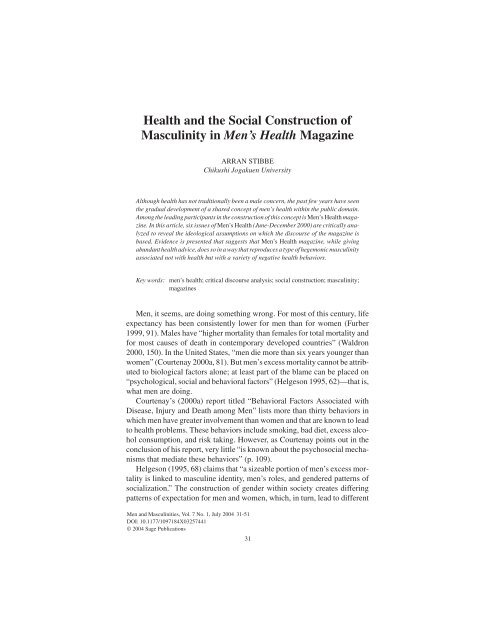
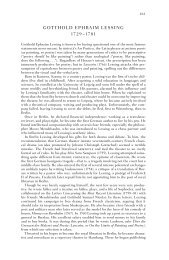

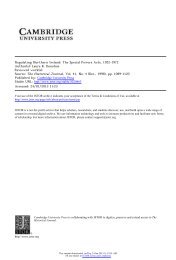

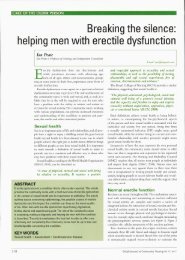
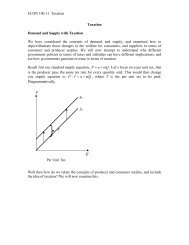
![The Rink - Cyril Dabydeen[1].pdf](https://img.yumpu.com/21946808/1/155x260/the-rink-cyril-dabydeen1pdf.jpg?quality=85)

